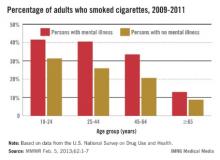The rate of cigarette smoking among mentally ill adults is 70% higher than among adults without a mental illness and is particularly high in certain groups, including young adults, according to a report released Feb. 5 by the Centers for Disease Control and Prevention and the Substance Abuse and Mental Health Services Administration.
The estimates are based on data from SAMHSA’s 2009-2011 National Survey on Drug Use and Health, which calculated the rates of cigarette smoking among people aged 18 years and older in the United States who reported having "any mental illness," defined as "a diagnosable mental, behavioral, or emotional disorder, excluding developmental and substance use disorders" in the past year.
During this period, 36.1% of adults with a mental illness were current smokers, compared with 21.4% of adults with no mental illness. Those with a mental illness who smoked were heavier smokers, smoking an average of 331 cigarettes a month, compared with 310 a month among adult smokers who do not have a mental illness.
Wide variations were found in the proportion of people with a mental illness who smoked across states, ranging from a low of 18.2% in Utah to almost 50% in West Virginia. In addition to younger adults, the gap in smoking rates was particularly stark among certain populations, including American Indians and Alaska natives (54.7% of those with a mental illness smoked vs. 30.5% of those who did not have a mental illness) and people living below the poverty line (48% vs. 33%). Rates were also higher among people with a mental illness who had lower levels of education (47% among those with less than a high school education and 40.2% of those with a high school education, vs. 19% of college grads).
During a telebriefing held to announce the results, CDC director Dr. Thomas Frieden emphasized that although adults with mental illness smoke more and are less likely to quit, smoking cessation programs work but are underused in this population, and more efforts should be directed toward helping adults with mental illness quit successfully.
"People with mental illness who smoke want to and can quit, and more needs to be done to provide them with the resources and services to help them quit successfully," including making mental health facilities tobacco- and smoke-free, he said at the telebriefing, which was sponsored by the CDC.
The CDC report refers to the activities developed by SAMHSA and the Smoking Cessation Leadership Center to promote smoking cessation efforts in behavioral health care settings. These activities include expansion of the "100 Pioneers for Smoking Cessation Campaign," which provides support for mental health facilities and organizations, according to the CDC press release.
The CDC report is available here. Information on quitting smoking, including a link for health care professionals, is available at www.smokefree.gov.


